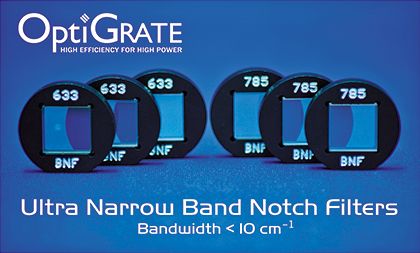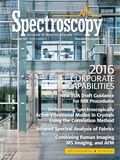OptiGrate Corp.
Company Description
OptiGrate Corp. designs and manufactures ultra-narrow band optical filters based on volume Bragg grating (VBG) technologies in proprietary photo-thermo-refractive glass. Filters with ultra-narrow bandwidth are formed by holographic techniques in the bulk of glass material, and demonstrate superior optical quality, outstanding durability, environmental stability, and high optical damage threshold. OptiGrate is a pioneer and world leader in VBG technologies. For over 15 years, OptiGrate has delivered holographic optical elements (HOE) to a large number of government contractors and OEMs in optoelectronics, analytical, medical, defense, and other industries.

Markets
OptiGrate supplied ultra-narrow band filters to hundreds of customers on five continents. These filters are used for: Raman spectroscopy and microscopy; semiconductor, solid state, and fiber lasers; hyperspectral and Raman imaging systems; ultrafast laser systems; optical recording and storage; medical diagnostics and treatment; and more.
Main Product Lines
- Ultra-narrow band optical notch and bandpass filters with linewidth less than 10 cm-1
- Laser resonator mode selection filters/mirrors for spectral narrowing and thermal stabilization of lasers
- Deflectors - transmitting volume Bragg gratings for angular filtering and deflection of laser light
- Chirped volume Bragg gratings for compact and robust stretchers and compressors of ultra-short laser pulses
- Spectral beam combiner - angular and spectral filters for high-power laser spectral beam combining

Facilities
OptiGrate moved to a new location in Oviedo, Florida, to accommodate an increased demand for the firm’s volume Bragg grating (VBG) products and allow for future expansion. The new 10,000 sq. ft., state-of-the-art facility was specially designed and engineered for production of VBG filters. The facility-the only vertically integrated VBG production plant in the world-includes a photo-thermo-refractive glass production unit, a VBG holographic production unit, and a VBG laser application development lab.
OptiGrate Corp.
562 South Econ Circle
Oviedo, FL 32765
TELEPHONE
(407) 542-7704
FAX
(407) 542-7804
E-MAILinfo@optigrate.com
WEB SITEwww.optigrate.com
NUMBER OF EMPLOYEES
40
YEAR FOUNDED
1999

Best of the Week: AI and IoT for Pollution Monitoring, High Speed Laser MS
April 25th 2025Top articles published this week include a preview of our upcoming content series for National Space Day, a news story about air quality monitoring, and an announcement from Metrohm about their new Midwest office.
LIBS Illuminates the Hidden Health Risks of Indoor Welding and Soldering
April 23rd 2025A new dual-spectroscopy approach reveals real-time pollution threats in indoor workspaces. Chinese researchers have pioneered the use of laser-induced breakdown spectroscopy (LIBS) and aerosol mass spectrometry to uncover and monitor harmful heavy metal and dust emissions from soldering and welding in real-time. These complementary tools offer a fast, accurate means to evaluate air quality threats in industrial and indoor environments—where people spend most of their time.